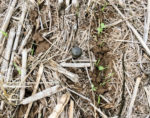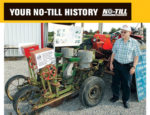Advertise Follow Us
No-Till Farmer

View Archived Issues
July 2022
Volume: 51
Edition: 7
Get full access NOW to the most comprehensive, powerful and easy-to-use online resource for no-tillage practices. Just one good idea will pay for your subscription hundreds of times over.
-
Table of Contents
Table of Contents
Digital Subscribers enjoy full access to No-Till Farmer's premium content. A paid subscription is required in order to read these stories.Are you a Premium or Digital subscriber? You enjoy:
- Unlimited access to all digital content here
- Freedom to view No-Till Farmer on all your devices
- Gleaning years of knowledge from the world's largest online library dedicated to no-till practices
Are you a Print only subscriber? Easily upgrade your subscription today! For only $10 more on a one year option, you gain the benefits of both the print edition delivered to your door and unlimited access to thousands of online pages of no-till content.
Farming Less and Doing a Better Job with No-Till
Southern Ohio grower Ron Bolender knows the benefits of no-till, having transitioned from raising labor-intensive tobacco to no-till corn and soybeans. While he’s expanded his acreage dramatically, his current operation is much easier on him and the soil.Read MoreZeroing in on Nitrogen Efficiency with In-Season Adjustments
Whether using high-tech crop imagery or intuition, in-season nitrogen applications should be adjusted to the crop’s potential as well as future conditions for maximum yield and minimal risk.Read MoreWhat I've Learned from No-TillingNo-Till, Double-Cropping Provide Steady Results for Michigan Dairy
Clair Armbrustmacher continues to advance his successful but somewhat solitary no-till system to include twin-row and cover crops.Read MoreFarming the Drought with No-Till Flexibility
Veteran Kansas no-tiller farms around dry High Plains weather, seeking to eliminate summer fallow when possible and using conserved soil moisture to grow something on every acre throughout the season.Read MoreFirst Planter Design from No-Till’s ‘Garden of Eden’
Donnie Morris built 3 no-till planters to move legendary agronomist George McKibben’s no-till experiments forward in Dixon Springs, Ill.Read MoreAuto-Steer, Field Mapping Most Popular Precision Technologies for No-Tillers
More than half of farmers who responded to the 14th annual No-Till Operational Benchmark Study plan to use auto-steer, field mapping and yield monitor data on their farms this year.Read MoreInsects as Indicators for Plant Health
Entomologist Thomas Dykstra’s Leaf Brix chart provides a way to identify unhealthy crops.Read MoreDouble-Crop Soybeans Prove Profitable for Young Operation
John and Alexander Young of Herndon, Ky., share tips for success from 55 years of double-cropping soybeans.Read MoreA Brief History of Carbon Markets
How global politics, market forces, environmental science and the back 40 are still colliding.Read MoreAhead of the CurveOn-the-Go Weed Control
Driven by increasing occurrences of herbicide resistance and a push to reduce pesticide use, the companies behind today’s weed control innovations are leveraging everything from artificial intelligence to lasers to drones to target weeds where they grow.Read More -
Featured Articles
Featured Articles
Farming Less and Doing a Better Job with No-Till
Southern Ohio grower Ron Bolender knows the benefits of no-till, having transitioned from raising labor-intensive tobacco to no-till corn and soybeans. While he’s expanded his acreage dramatically, his current operation is much easier on him and the soil.Read MoreWhat I've Learned from No-TillingNo-Till, Double-Cropping Provide Steady Results for Michigan Dairy
Clair Armbrustmacher continues to advance his successful but somewhat solitary no-till system to include twin-row and cover crops.Read More - Digital Edition

.png?height=125&t=1731942302&width=150)













